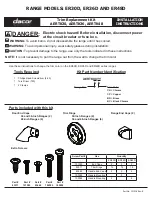
English
23
Defrosting should not be carried out in a warm oven or when
an adjoining oven is in use or still warm.
Ensure that dairy foods, meat and poultry are completely
defrosted before cooking.
Fan oven
This function operates the fan and the heating
element around it. An even heat is produced
throughout the oven, allowing you to cook large amounts
quickly.
Fan oven cooking is particularly suitable for baking on several
shelves at one time and is a good ‘all-round’ function. It may
be necessary to reduce the temperature by approximately
10°C for recipes previously cooked in a conventional oven.
If you wish to pre-heat the oven, wait until the indicator light
has gone out before inserting the food.
Fanned grilling
This function operates the fan whilst the top
element is on. It produces a more even, less fierce
heat than a conventional grill. For best results, place the food
to be grilled, on a grid over a roasting tin, which should be
smaller than a conventional grill pan. This allows greater air
circulation. Thick pieces of meat or fish are ideal for grilling
in this way, as the circulated air reduces the fierceness of
the heat from the grill. The oven door should be kept closed
whilst grilling is in progress, so saving energy. You will also
find that the food needs to be watched and turned less than
for normal grilling. Pre-heat this function before cooking.
Fan assisted oven
This function operates the fan, circulating air heated
by the elements at the top and the base of the oven.
The combination of fan and conventional cooking (top and
base heat) makes this function ideal for cooking large items
that need thorough cooking, such as a large meat roast. It is
also possible to bake on two shelves at one time, although
they will need to be swapped over during the cooking time,
as the heat at the top of the oven is greater than at the base,
when using this function.
This is a fast intensive form of cooking; keep an eye on the
food cooking until you have become accustomed to this
function.
Conventional oven (top and base heat)
This function combines the heat from the top and
base elements. It is particularly suitable for roasting
and baking pastry, cakes and biscuits. Food cooked on the
top shelf will brown and crisp faster than on the lower shelf,
because the heat is greater at the top of the oven than at the
base, as in ‘Fan assisted oven’ function. Similar items being
cooked will need to be swapped around for even cooking.
This means that foods requiring different temperatures can
be cooked together, using the cooler zone in the lower half of
the oven and hotter area to the top.
Browning element
This function uses the element in the top of the
oven only. It is a useful function for the browning or
finishing of pasta dishes, vegetables in sauce and lasagne, the
item to be browned being already hot before switching to
the top element.
Base heat
This function uses the base element only. It will
crisp up your pizza or quiche base or finish off
cooking the base of a pastry case on a lower shelf. It is also
a gentle heat, good for slow cooking of casseroles in the
middle of the oven or for plate warming.
The Browning and Base heat functions are useful additions
to your oven, giving you flexibility to finish off items to
perfection. With use, you will soon realise how these
functions can combine to extend your cooking skills.
The Right-hand Oven
The fan in the right hand oven circulates hot air continuously,
which means faster more even cooking.
The recommended cooking temperatures for a fanned oven
are generally lower than a non-fanned oven.
The right hand fan oven control is at the right hand end of
the control panel.
Turn the oven temperature knob to the temperature you
need.
The oven indicator light will glow until the oven has reached
the temperature you selected. It will then cycle on and off
during cooking.
Both Ovens
Please remember that all cookers vary - temperatures in your
new Elan ovens may differ to those in your previous cooker.
The wire shelves should always be pushed firmly to the back
of the oven.
Baking trays meat tins etcetera should be placed level
centrally on the oven’s wire shelves. Keep all trays and
containers away from the sides of the oven, as overbrowning
of the food may occur.
For even browning, the maximum recommended size of
a baking tray is 340mm by 340mm for the main oven and
230mm by 320mm for the Tall oven.
Cooking high moisture content foods can create a ‘steam
burst’, when the oven door is opened. When opening the
oven stand well back and allow any steam to disperse.
When the oven is on, don’t leave the door open for longer
than necessary, otherwise the knobs may get very hot.
Always leave a ‘fingers width’ between dishes on the same
shelf; this allows the heat to circulate freely around them.
The Cook & Clean oven liners (see '
Cleaning your cooker
')
work better when fat splashes are avoided. Cover meat when
cooking.
To reduce fat splashing when you add vegetables to hot fat
around a roast, dry them thoroughly or brush lightly with
cooking oil.
Sufficient heat rises out of the oven while cooking to warm
plates in the grill compartment.
If you want to brown the base of a pastry dish, preheat the
baking tray for 15 minutes before placing the dish in the
centre of the tray.
Where dishes may boil and spill over during cooking, place
them on a baking tray.
















































